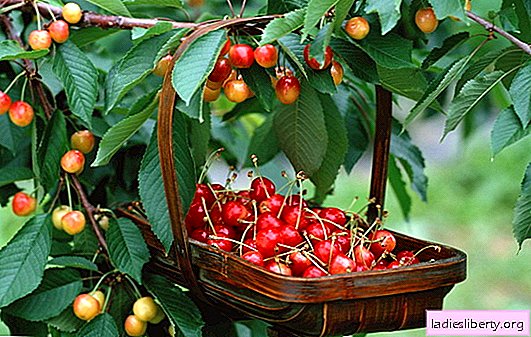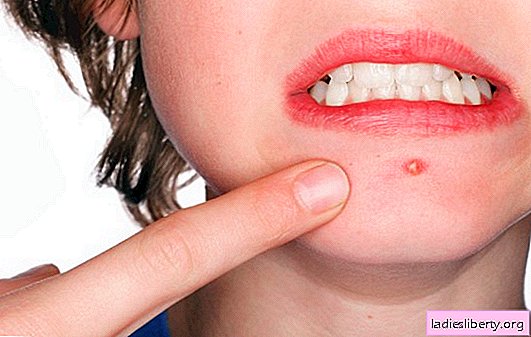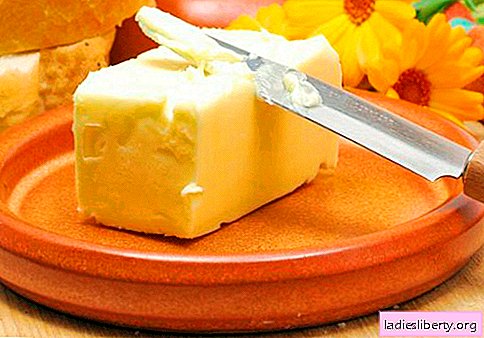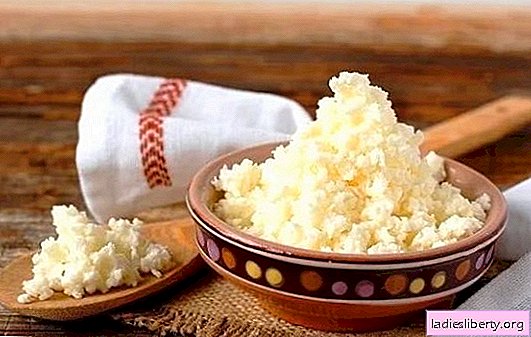
Sweet cherry is a woody plant famous for decorative flowering and juicy sweet fruits.
Unlike its kindred cherry, cherries bear more sweet and large drupes.
The plant is quite thermophilic, does not tolerate freezing of the soil and does not like open, purged habitats; best survives and gives a greater harvest in the southern regions of Russia.
But thanks to the work of breeders, it became possible to grow some varieties of cherries in more northern latitudes.
Cherry: planting, variety selection
When planting, it should be borne in mind that the plant prefers soils with a high humus content, does not like clay and sandy soils. Cherry should be planted in well-lit areas of the estate, hidden from strong winds. It is recommended to plant several seedlings at once (you can have different varieties), this increases the likelihood of cross-pollination, which positively affects the yield. Tree planting can also be done next to cherries, the pollen of which is excellent for pollinating cherries.
In regions with a mild climate, it is recommended to plant cherries in the fall, and in the northern regions in the spring. Before planting, you should check that the roots of the plant are approximately the same length, if necessary, they must be trimmed and lowered for several hours in water. At 3-5 meters from each other, landing pits are excavated with a depth of 50-80 cm and up to 1 m in diameter.

Sapling hole
Then you need to prepare the soil mixture: for this, 2 buckets of soil should be mixed with 2-3 buckets of manure, add 1 kg of ash. It is also recommended to add potash fertilizers, ammonium sulfate and superphosphate. With the resulting mixture, line the bottom of the landing pit, making a small mound in the center. A column is inserted into the elevation to support the seedling, a seedling is placed next to it: the roots should be straightened, evenly distributed throughout the mound. The plant is tied to a support column, after which it is gradually sprinkled and the soil is slightly compacted.
It is important to prevent deepening of the cherry, its root neck when planting should correspond to the level of the soil or be a couple of centimeters higher. At the end, watering is carried out (2-3 buckets for each seedling) and the soil is mulched with humus, peat or leaf decay.

The scheme of planting cherries. Root neck - 8
To date, more than 3,000 varieties of cherries are known, differing from each other in color and taste of fruits, as well as winter hardiness and fruiting periods.
Early cherries by the end of May already form fruits. They should be consumed fresh, since early cherries do not tolerate storage and preservation. Popular early varieties are Household Mayskaya, Early Duki, Skorospelka, Valery Chkalov and others. Of the mid-ripening varieties beginning to bear fruit by the end of June, one can distinguish Orlovskaya pink, Donchanka, Sylvia, etc. In July, the fruits of the late varieties ripen: Romance, Raisins, Bryanskaya pink, Leningrad black, etc.
For the central part of Russia, Iput, Chermashnaya, and Rechitsa varieties are suitable. In the southern regions of Russia, Robin, Julia, Assol, and Crimean Black take root well. Varieties Fatezh, Lyubimitsa Astakhova, Raditsa are adapted to the harsh conditions of the Urals (frosts tolerate well, but need shelter in the cold season).
Sweet cherry: leaving (photo)
Care for the cherries for an experienced gardener is simple, it includes: loosening the soil and removing weeds; watering; crown pruning; top dressing.
Around the cherry tree should form a trunk circle with a diameter of 1 m or more; on this site, loosening and purification of the substrate from weeds is carried out. Each year, the circle should be expanded slightly. The tree should be watered 3 times during the summer (more often in dry seasons).
Pruning is done every year in early spring (in March), without waiting for swelling of the kidneys. This removes dried and weak shoots, broken branches. The places of cuts should be covered with a special garden ointment, which will prevent the penetration of pests under the bark. The shape of the crown should be monitored, as the large thickening of the branches will interfere with the penetration of sunlight and pollinating insects to the center of the crown, which will negatively affect the yield of sweet cherry.
When undercutting, attention should be paid to the fact that it is not recommended to leave long branches. You can not cut the branches and very close to the bearing, as this can lead to damage to the conductive shoot system - and the branch will dry. How to cut the sweet cherry is shown in the photo.

At the young tree, the lower shoots are cut by 50 cm, the central axis of the tree is selected, and its branches are shortened so that the main axis is 6 buds higher. To give the tree a sparse-tier structure of the crown, it is necessary to select 4-6 support branches for 2-3 years after planting, cut the remaining large branches (remove those branches that grow down). Three-year-old cherries form 2 tiers, consisting of 3-5 supporting shoots (excess ones are removed). In the fourth or fifth year, the cherry already has 4-5 tiers and enters the fruiting stage, from now on it needs only spring shortening of shoots and the fight against thickened crowns.
Sweet cherry: top dressing
Care for cherries includes fertilizing with various mineral and organic fertilizers, which are applied in early spring or autumn. Trees are fed in order to increase their productivity, but it is important to correctly calculate the dosage, because excessive doses can lead to the opposite result.
In the first spring after planting around the trunk 120 g of mineral nitrogen-containing fertilizers are poured, which are embedded in a substrate to a depth of 10 cm.
Urea can also be added at the beginning of May: up to 30 g per 10 liters of water for each tree. Before this, it is recommended to loosen the soil a little, which will provide faster penetration of substances to the root system. With age, the amount of fertilizer during feeding increases: So, by the fourth year, the dosage of urea is already up to 150-200 g (depending on the size of the tree).
Having reached 5 years of life, plants begin to need phosphate fertilizers. In autumn, a solution of superphosphate (up to 60 g per 1 m2) is introduced into the soil of the trunk circle.
Wood ash is one of the most affordable and useful fertilizers. To feed the sweet cherry, you need to dissolve 1 kg of ash in 10 liters of water.
Organic fertilizers use slurry (1 kg per bucket of water).
Green fertilizers are very popular. Between the trees you can make beds and plant legumes on them by mid-summer. In autumn, grasses are mowed and embedded in the soil of the tree circle.
Sweet cherry: pests and diseases
The main diseases of cherry trees are diseases of a bacterial and fungal nature.
Plants are more susceptible to bacterial ulcers in the spring, when bacteria are transferred along with the flowing rain water throughout the plant. Symptoms of this disease are the appearance of sores on the branches, dying of bark, brown spots with a golden border on the leaves, which can fall by the middle of the growing season. In order to protect the cherry garden from bacterial infections, it is necessary to treat wounds and saw cuts on trees with a special garden blast in time, to prevent excessive watering. You can also pick disease-resistant varieties.
One of the fungal diseases is coccomycosis, which first affects berries and leaves, and in subsequent years can lead to the death of cherries. Small brown spots appear on the leaves (on the back side you can see a pinkish coating of mushroom mycelium). By mid-June - early July, the leaves fall off, photosynthesis stops, which leads to a halt in the development of fruits that dry and crumble. To prevent fungal infection, you need to treat the plant with a solution of copper sulfate during swelling of the kidneys, and before flowering with a beard mixture.
Another fungal ailment is cherry rot. Brown spots appear on the fruits, which quickly grow and become covered with grayish mold mycelium (shown in the photo). Such berries infect neighboring ones, the infection spreads very quickly, especially in warm, humid weather. It is necessary to carefully remove all affected drupes.

Cherry Rot
Cherry monilliosis gets sick during flowering. The spores of the fungus fall on the flower and through the pestle infectious hyphae are allowed inside the shoots and reach the trunk. The fungus produces toxins that destroy wood. Outwardly, the disease is expressed in the browning of young shoots and buds. To save an infected tree, you need to cut off a diseased branch, capturing 10-15 cm of an apparently healthy area, and burn it. Place saw cut sanitized.
Powdery-mildew fungi cause a delay in the development of the seedling and the drying of the leaves. The mycelium has the appearance of a whitish coating on the leaves. For the fight and prevention use a solution of potassium permanganate or the drug "Topaz".
But the main pest of cherries and cherries is a cherry fly. She feeds on the juice of young leaves and fruits, and also lays eggs on plants. For a week, larvae emerge from the eggs and damage the pericarp when feeding, which makes the drup flank fail. The fruit rots and falls off, and the larva leaves in the soil and turns into a chrysalis. To combat the cherry fly, it is necessary to regularly clean the fennel and spray the cherry plantings with insecticides several times from the moment of flowering.











